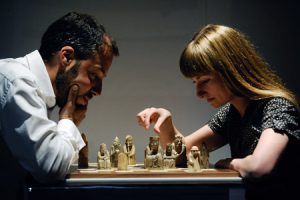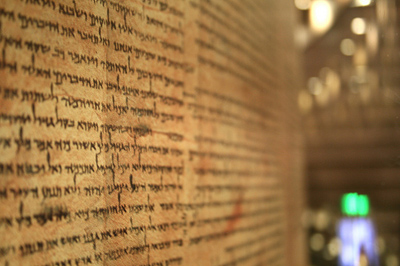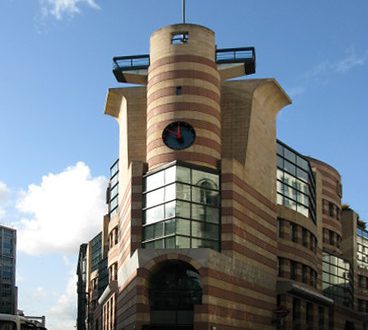 I’ve had something of a crash-course on the subject of the Lewis Chessmen since it was announced back in October last year that pieces from the London and Edinburgh collections would be reunited for a major touring exhibition of Scotland running throughout 2010 and 2011.
I’ve had something of a crash-course on the subject of the Lewis Chessmen since it was announced back in October last year that pieces from the London and Edinburgh collections would be reunited for a major touring exhibition of Scotland running throughout 2010 and 2011.
I researched the story of the Lewis Chessmen for this article, blogged on the findings of new research on their origins and usage, pitted them against King Tut’s ivory senet board in a face-off, and reported on the premiere last month of the exhibition at the National Museum of Scotland (NMS).
I was beginning to consider myself a bit of an expert. But there was still so much more to be learned and understood about these fascinating and enchanting 12th/13th century ivory-carved gaming pieces from Scandinavia, as I discovered when I finally met them face-to-face at the Lewis Chessmen Unmasked exhibition, and had a chat with NMS Keeper of Scotland and Europe Dr David Caldwell.
Filtered off into small, complimentary batches in a row of glass cabinets, surrounded by other medieval artefacts of relevance – such as a Viking sword, items of jewellery, a bell shrine from Kilmichael Glassary in Argyll and a decorated horse harness – the Chessmen are quite a sight to behold, and have a haunting, almost life-like quality about them. The at once melancholic and humorous expressions on their faces – each of them unique – can only be fully appreciated when viewed up close. Elsewhere in the special exhibition space there’s a ten minute short film about the Chessmen’s discovery – in Gaelic with English subtitles – screening on a loop, and a set of boards where you can sit down and play chess or the medieval Norse game of Hnefatafl.
Here’s my top ten new facts I learned about the Lewis Chessmen from the visit and conversation with Dr Caldwell, covering everything from the story behind their enchanting expressions to a new theory on when and where on Lewis they were found, why it’s unlikely that a handful of missing Chessmen will ever be found, and why the 82 pieces owned by the British Museum will most likely never be repatriated.
1. They’re One of a Kind
“There are other single pieces that have turned up around Europe,” reports Dr Caldwell, “but the Lewis Chessmen are by far the biggest and best hoard of such things.”
Several individual medieval ivory chess pieces can be viewed at places such as The Louvre and The National Museum in Denmark, but very few are directly comparable to the Lewis Chessmen. “There are one or two pieces that are very close, including part of a knight that comes from Lund in Sweden, and a now lost broken queen that came from Trondheim itself.” Yet Dr Caldwell isn’t ruling out more surfacing in the future. “Other pieces may turn up here and there,” he says.
2. There’s An Odd One Out
While research on the faces of the Lewis Chessmen by forensic anthropologist Dr Caroline Wilkinson has determined that the pieces were probably carved by five different craftsmen, there’s a general uniformity visible across the set. “Although we might be dealing with five different craftsmen, they were probably all based in the same workshop,” notes Dr Caldwell.
But for a single king, that is, which may have been a later replacement for a lost original. “There’s one of the pieces that we’ve highlighted who I think looks so different it’s probably from a different workshop somewhere else. It could be a different town even – it’s certainly somewhere else altogether.”
3. The Chessmen’s Creators Were Having a Laugh
If the Chessmen’s bug-eyed, worried expressions appear comical to you, that’s probably because they’re supposed to. “I think in lots of ways, humans haven’t changed over the years,” says Dr Caldwell. “I think it’s very likely that craftsmen would have had the same emotions and the same ways of thinking as we do now. When we have these images of the warriors biting the shields, I think that’s very likely to be a gentle bit of poking fun at contemporaries.”
Yet while the craftsmen might have been having fun while carving the Chessmen, they may also have been attempting to exaggerate certain physical qualities which were seen as beautiful in the medieval period.
“Some of them have very sort of bulging eyes. It’s possible that that might have been seen as an attractive feature in some ways. While a lot of our emotions haven’t changed over the years, our sense of what is good has. A classic example of that are paintings by Reubens from the 17th century. He painted a lot of voluptuous ladies in a way that would not feature in the pages of Hello magazine nowadays.”
4. You Can Play More than Just Chess with the Chessmen
We’ve already reported on the fact that it’s believed the Lewis Chessmen may have been used for playing the Medieval Norwegian board game Hnefatafl rather than chess. According to Dr Caldwell, the Chessmen probably comprised part of a versatile set which could actually be used for playing up to three or four different board games.
“Basically what we’re dealing with is a gaming compendium,” he explains. “It’s like one of these cardboard boxed you get at Christmas with tiddly-winks in it and maybe dice.
“It’s like that, except it’s bigger and fancier – it included four sets for playing chess; it included a lot of table men for playing some game like draughts or backgammon. Probably what we now regard as chessmen were supposed to double for playing this other game Hnefatafl.”
5. It’s Impossible to Put a Price on Them
“None of the chessmen have appeared on the market since the 19th century,” explains Dr Caldwell, when I ask him what sort of sum the Lewis Chessmen would fetch if they were put up for sale today. “The British Museum got 82 for something like £84 – so at that time in 1841, they were being valued at about a pound a time. So I think they drove quite a hard bargain. Now I think that if some came up at auction, the figure would be very, very large indeed.
“We say they’re treasures, and they are treasures – they’re invaluable in all sorts of ways. Monetary value is something we never have to bother ourselves with, perhaps apart from insurance.”
6. The Chessmen May Have Been Found 50 Years Earlier Than Is Believed
In the process of writing a research paper on the Lewis Chessmen recently, Dr Caldwell uncovered evidence that the Lewis Chessmen may have been found at the medieval settlement of Mèalasta rather than the sand dunes of Uig Bay, where they’re commonly said to have been discovered. Additionally, he also stumbled upon evidence which he thinks implies they were found half a century earlier than has been reported.
A team of Ordinance Survey mapmakers who visited Lewis in 1851 and interviewed local community leaders noted for Mèalasta: “Chessmen found here 70 years previously, taken to Edinburgh.”
“These are guys who were trained to make sure they got accurate information,” says Dr Caldwell. “I do now seriously wonder whether the Chessmen were actually found in 1780, and lurked around in somebody’s barn until they were rediscovered in 1831.”
7. There Probably Aren’t Any More Intact Pieces Still Out There
“We’re missing several pieces – several pawns and at least I think three of the face pieces,” Dr Caldwell notes, of the dozens of absentee Chessmen that leave the collection shy of four or five full sets.
“The reason we haven’t got them I think is quite simple – that the finder, well, he didn’t quite appreciate the value of them or what they were. He seems to have picked the pieces which were in perfect condition, and he’s picked up ones which don’t look too good, and he’s picked up ones which are chipped or have bits missing.”
The remaining Chessmen were most likely just tiny broken, fragments deemed not worthy of collection. “I think it’d be reasonable to predict that there were probably several other pieces – literally pieces – and he wasn’t bothered with them.”
8. But There Are Enough Pieces to Play a Full Game of Chess
Is it actually possible, I ask Dr Caldwell, in light of the fact that a number of pieces are missing, for two players to sit down over a board and play a full game of chess with the Lewis Chessmen?
“Yes, I think so,” he replies. “I think there’s only three of the face pieces missing, and a lot of pawns. But I think there’s enough. You would need sixteen pawns, and there are at least 16 pawns. I’ve never been asked that one before!”
9. There’s No Case for Repatriation
According to Dr Caldwell, there’s no grounds – morally or practically – for the NMS or any other Scottish museum to claim the Lewis Chessmen should be returned north on a permanent basis by the British Museum, which purchased them entirely legitimately from the Scottish antiquarian Charles Kirkpatrick Sharpe.
“There is no case for repatriation in my personal opinion – and I think it chimes in with what the two museums are saying. Once you start repatriating objects from museums, they’re all the losers. I frankly think it’s important that major museums, whether they’re here or in North America or in Greece or wherever else in the world, ought to be able to show to their people and their visitors human endeavour in different parts of the world.
“We’re very fortunate that the Chessmen have been in the British Museum, when they could have been split up all over the world, or in some other museum in some god-awful part of the world. The British Museum is a major international museum and lots of people see them there, and that is the name of the game.”
10. The National Museum of Scotland’s Pieces are the Pick of the Bunch
While the NMS may only have 11 Chessmen to the British Museum’s 82, Dr Caldwell believes that the very best pieces – among them the iconic warder chewing on his shield, a scowling king with his sword across his lap and a thoughtful-looking bishop with is hand raised in blessing – are the few which reside in Scotland.
“That’s not my prejudice, my bias – Charles Kirkpatrick Sharpe clearly had a very good eye,” says Dr Caldwell, “and he picked 10 good ones. And we do always have them on display here.”




